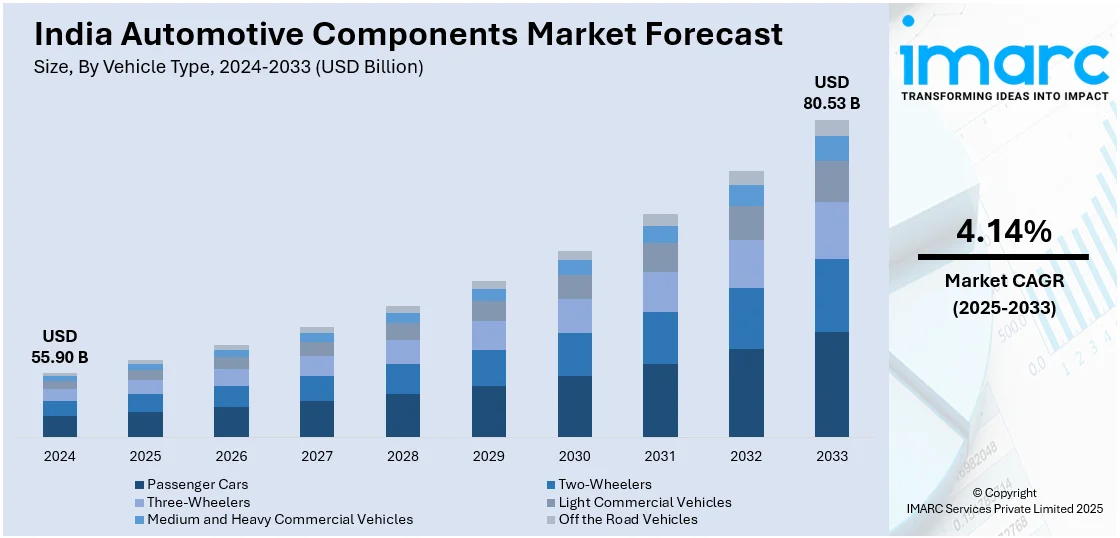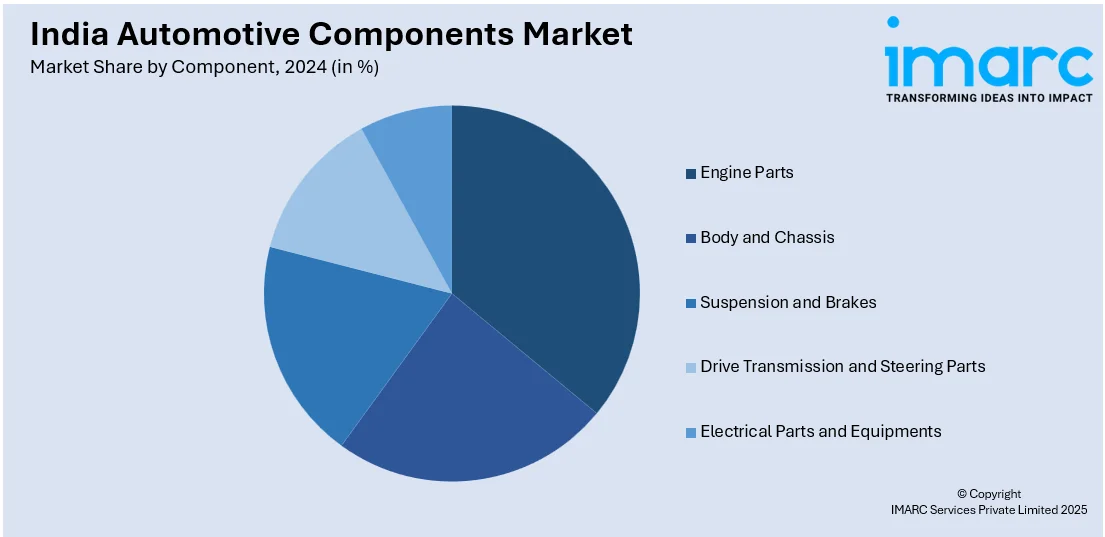
India Automotive Components Market Size, Share, Trends and Forecast by Vehicle Type, Component, Demand Category, and Region, 2025-2033
India Automotive Components Market Overview:
The India automotive components market size reached USD 55.90 Billion in 2024. Looking forward, IMARC Group expects the market to reach USD 80.53 Billion by 2033, exhibiting a growth rate (CAGR) of 4.14% during 2025-2033. The increasing vehicle production, rising demand for electric vehicles (EVs), government initiatives like the PLI scheme, enhanced localization efforts, investments in research and development (R&D), and the rising preference for lightweight and high-performance components are boosting market expansion.
|
Report Attribute
|
Key Statistics
|
|---|---|
|
Base Year
|
2024
|
|
Forecast Years
|
2025-2033
|
|
Historical Years
|
2019-2024
|
| Market Size in 2024 | USD 55.90 Billion |
| Market Forecast in 2033 | USD 80.53 Billion |
| Market Growth Rate 2025-2033 | 4.14% |
India Automotive Components Market Trends:
Surge in Electric Vehicle (EV) Component Manufacturing
India’s electric vehicle (EV) market is witnessing rapid growth, driving a surge in demand for specialized automotive components. With the government targeting 30% EV adoption by 2030, manufacturers are scaling up production of key components such as battery packs, power electronics, and lightweight materials. EV sales in India soared by 155% in 2023, according to the Society of Indian Automobile Manufacturers (SIAM), and are projected to reach 2 million units annually by 2025. Given that batteries constitute 40-50% of an EV’s total cost, investments in localized battery manufacturing are gaining momentum. Leading companies like Tata AutoComp Systems and Bosch India are actively developing indigenous battery management systems and electric drivetrains to reduce import dependency. Additionally, the government’s Production Linked Incentive (PLI) scheme for the auto sector, with a budget of ₹25,938 crore (approximately $3.2 billion), is encouraging investments in EV components and further fueling market growth. The localization of lithium-ion battery production is expected to lower costs by 15-20% by 2025, making EVs more affordable and accelerating their widespread adoption across the country.

To get more information on this market, Request Sample
Advanced Lightweight Materials and Sustainable Manufacturing
The increasing need for fuel efficiency and emissions reduction is accelerating the adoption of lightweight materials such as aluminum, carbon fiber composites, and high-strength steel in automotive manufacturing. As India’s Corporate Average Fuel Efficiency (CAFE) norms tighten by 2025, automakers must cut vehicle weight by 10-15% to meet stringent fuel efficiency targets. According to ICRA, the aluminum market within the Indian automotive components industry is projected to grow at a CAGR of 12% from 2023 to 2025, driven by the increasing use of lightweight engine parts and body structures. Companies like Jindal Aluminium and Hindalco are investing in high-strength aluminum alloys to reduce weight while maintaining durability. Sustainability is also becoming a key industry focus, with the growing adoption of recycled and bio-based materials. Leading automakers like Maruti Suzuki and Mahindra are integrating biodegradable interior components to align with environmental goals. With the enforcement of stricter BS-VI emission norms and the industry’s shift toward circular economy practices, sustainable materials are set to redefine the future of automotive components, reducing carbon footprints while enhancing performance.
India Automotive Components Market Segmentation:
IMARC Group provides an analysis of the key trends in each segment of the market, along with forecasts at the region/country level for 2025-2033. Our report has categorized the market based on vehicle type, component, and demand category.
Vehicle Type Insights:
- Passenger Cars
- Two-Wheelers
- Three-Wheelers
- Light Commercial Vehicles
- Medium and Heavy Commercial Vehicles
- Off the Road Vehicles
The report has provided a detailed breakup and analysis of the market based on the vehicle type. This includes passenger cars, two-wheelers, three-wheelers, light commercial vehicles, medium and heavy commercial vehicles, and off the road vehicles.
Component Insights:

- Engine Parts
- Body and Chassis
- Suspension and Brakes
- Drive Transmission and Steering Parts
- Electrical Parts and Equipments
A detailed breakup and analysis of the market based on the component have also been provided in the report. This includes engine parts, body and chassis, suspension and brakes, drive transmission and steering parts, and electrical parts and equipments.
Demand Category Insights:
- OEM
- Replacement
The report has provided a detailed breakup and analysis of the market based on the demand category. This includes OEM and replacement.
Regional Insights:
- North India
- South India
- East India
- West India
The report has also provided a comprehensive analysis of all the major regional markets, which include North India, South India, East India, and West India.
Competitive Landscape:
The market research report has also provided a comprehensive analysis of the competitive landscape. Competitive analysis such as market structure, key player positioning, top winning strategies, competitive dashboard, and company evaluation quadrant has been covered in the report. Also, detailed profiles of all major companies have been provided.
India Automotive Components Market News:
- March 2025: Maruti Suzuki, India's largest automobile manufacturer, announced an investment of around $864 million (74.1 billion rupees) to build a third factory at its Kharkhoda location in Haryana. This development seeks to raise the site's manufacturing capacity to 750,000 automobiles per year by 2029, meeting rising domestic and international demand.
- February 2025: Carlyle secured a majority stake in Highway Industries Limited and Roop Automotives Limited. This $400 million deal established a platform with a comprehensive product range and an extensive global clientele.
- January 2025: Tata Motors, India's biggest EV maker, revealed intentions to invest $1.5 billion in a battery gigafactory in India, which is slated to begin production in 2026.This effort intends to ensure a local supply of lithium-ion battery cells, the costliest component of EVs, while also maintaining Tata's competitive advantage in India's robust EV industry.
India Automotive Components Market Report Coverage:
| Report Features | Details |
|---|---|
| Base Year of the Analysis | 2024 |
| Historical Period | 2019-2024 |
| Forecast Period | 2025-2033 |
| Units | Billion USD |
| Scope of the Report |
Exploration of Historical Trends and Market Outlook, Industry Catalysts and Challenges, Segment-Wise Historical and Future Market Assessment:
|
| Vehicle Types Covered | Passenger Cars, Two-Wheelers, Three-Wheelers, Light Commercial Vehicles, Medium and Heavy Commercial Vehicles, Off the Road Vehicles |
| Components Covered | Engine Parts, Body and Chassis, Suspension and Brakes, Drive Transmission and Steering Parts, Electrical Parts and Equipments |
| Demand Categories Covered | OEM, Replacement |
| Regions Covered | North India, South India, East India, West India |
| Customization Scope | 10% Free Customization |
| Post-Sale Analyst Support | 10-12 Weeks |
| Delivery Format | PDF and Excel through Email (We can also provide the editable version of the report in PPT/Word format on special request) |
Key Benefits for Stakeholders:
- IMARC’s industry report offers a comprehensive quantitative analysis of various market segments, historical and current market trends, market forecasts, and dynamics of the India automotive components market from 2019-2033.
- The research report provides the latest information on the market drivers, challenges, and opportunities in the India automotive components market.
- Porter's five forces analysis assist stakeholders in assessing the impact of new entrants, competitive rivalry, supplier power, buyer power, and the threat of substitution. It helps stakeholders to analyze the level of competition within the India automotive components industry and its attractiveness.
- Competitive landscape allows stakeholders to understand their competitive environment and provides an insight into the current positions of key players in the market.
Key Questions Answered in This Report
The automotive components market in India was valued at USD 55.90 Billion in 2024.
The India automotive components market is projected to exhibit a CAGR of 4.14% during 2025-2033, reaching a value of USD 80.53 Billion by 2033.
Rising vehicle production, demand for fuel efficiency, focus on electric mobility, government incentives, technological upgrades, export opportunities, localisation efforts, cost competitiveness, and a growing aftermarket boost India’s automotive components sector. OEM partnerships and foreign direct investments push domestic players to scale and innovate.
Need more help?
- Speak to our experienced analysts for insights on the current market scenarios.
- Include additional segments and countries to customize the report as per your requirement.
- Gain an unparalleled competitive advantage in your domain by understanding how to utilize the report and positively impacting your operations and revenue.
- For further assistance, please connect with our analysts.
 Request Customization
Request Customization
 Speak to an Analyst
Speak to an Analyst
 Request Brochure
Request Brochure
 Inquire Before Buying
Inquire Before Buying




.webp)




.webp)












